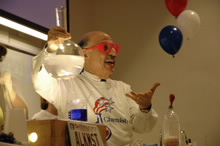Presentation Tips for Young Audiences
Whenever you talk about chemistry with young audiences, in classroom presentations or large public shows, you have a great opportunity to interest them in chemistry and inspire them to learn more. When you speak with kids about chemistry, try to remember to interest them in science while speaking in their terms.
- Plan Your Classroom Visit – simple steps for contacting a teacher and preparing activities
- Science Safety Guidelines – a guide to incorporating safe practices into your activity
Effective presentation tips:
Introduce yourself and the activity
Let the children know something about you as a person. Was there a special individual or event in your life that first aroused your interest in science? What do you most love about chemistry? What do you love most about your particular field? Keep in mind that you may be the only chemist these children have ever met!
Use a demonstration, introductory activity, or story to get the students’ attention and motivate them to want to find out more. Plan your lesson around a question that students will investigate with you. By the end of your lesson, students should be able to use evidence from their activities to answer the question. Children love science when it is taught as an extension of their natural curiosity.
Prepare the students for the unexpected. Loud noises, bright lights, and unusual odors can disturb and frighten some students. Warn students if something unexpected is coming.
Facilitate thinking and learning
Let the children learn by doing. Don’t tell them what to expect in a demo or hands-on activity. Let them see for themselves and then ask them to describe their observations. Encourage them to think about possible explanations for the results. If possible, provide time for the students to test their ideas.
Stimulate thinking by asking questions. Questions that ask children to make a prediction, give an explanation, state an opinion, or draw a conclusion are valuable. Make sure students have enough background so that they can honestly consider the possibilities. You may want to write a list of questions to ask students as you plan your lesson. The best questions require more than a yes or no answer.
Be conscious of your vocabulary. Try not to use a complicated word when a simple one will do. Define words that students may not know and use simple definitions that relate to them.
- Acids and bases are chemical terms which describe substances that are a part of your everyday life. Lemons, oranges, and grapefruit contain acids. Hand soap, dish detergent, and laundry detergent contain bases.
- You can find polymers all around you. For example, many of the toys that you play with, including anything plastic, are made of polymers. Many clothes are made from polymers. Polymers are chemical compounds that are made of chains of molecules linked together by chemical bonds.
Use analogies, models, or activities. For example, when discussing polymers, you could have young students stand up to make a model of a polymer with their bodies. Explain that one student could represent a monomer; two or more monomers can link arms to form a polymer.
Leave positive messages about chemistry
Your classroom visit is an opportunity to introduce students to chemistry and inspire them to discover their world through science. Keep the following messages in mind:
- There’s a scientist in all of us. Anyone who is curious, observant, and questioning about the world we live in is already acting like a scientist.
- Chemistry is everywhere and contributes to everyone’s daily life. Anything that can be touched, tasted, smelled, seen or felt is made of chemicals.
- Chemists and chemistry drive innovations to discover solutions to problems and enhance our lives (e.g., find new drugs that can control disease, improve water and air quality, clean our environment, improve the food that we eat).
- Chemistry is an important profession, because careers in chemistry offer opportunities to change the world.
Leave more than a memory
Ask the children what they liked—or didn’t like—about your visit. Ask the teacher to let you know what kids thought about the activity and how well it helped students learn the concept you were teaching. Use their suggestions to enhance your next effort.
Even though your activity is through, don’t close the door to learning. Invite the teacher to contact you again next year, offer to be a science pen pal for the class, or help set up an experiment that students can continue after you leave. Perhaps most importantly, share additional ACS resources and materials for teachers and students and your business card so the class will have access to chemistry resources throughout the school year.
Speaking to Students

I try to impress on my audience three things: chemistry is everywhere, chemistry is everyday, and chemistry is for everyone.
One of the things that I do as I start a presentation is to ask students, “Have you done any science today?” Most of the audience usually answers “no.” I mention to them that if they haven’t done any science, then they’re like a rock. Does the rock breathe? Does it eat pizza? Then it doesn’t do science. However, if you are doing any of these activities, you are doing science. They start to get the idea.
I tell students that I don’t do magic, I do chemistry. “What do I have here?” Lemon juice, baking soda… everyday stuff that they are familiar with. I try to show them that science is all around us and that they do science everyday.
It pleases me a lot to do demonstrations. It’s fun and I tell folks that these kids are our future. If I can turn a student around, not necessarily to become a chemist, but to continue on learning, to be excited about learning, that makes my day.
Professor Al Hazari,
Chemistry Educator

